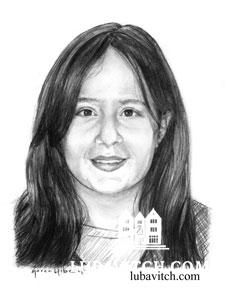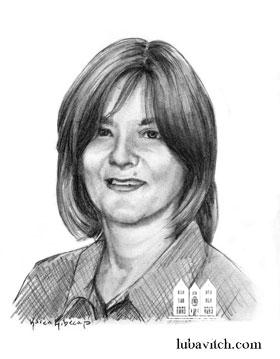Purim celebrates a familiar plot: A nation threatened with destruction is saved at the eleventh hour when its enemy’s plans are miraculously thwarted. Deliverance comes through Esther, introduced to us in the Megillah as a young, shy maiden, at first, unprepared when called upon by Mordechai to take action to save her people from annihilation.
The Baal Shem Tov teaches us that if we read it as a historic document without regard for its immediate relevance, we have not fulfilled the mitzvah of reading Megillat Esther on Purim.
In a way, we can read Esther’s story as a paradigm of the “evolution” of the traditional Jewish woman of our own day. We asked women in leadership to share some of the salient points in the Story of Esther that are instructive to them in their own lives.
Reluctant Hero
Sarah Alevsky
 The Megillah describes Esther as a passive player. Taken to the palace against her will, she does not “divulge her nationality or lineage” until instructed to do so by Mordechai. She seems to have accepted her situation as fate, and we see no indication of her trying to change her circumstances. When Mordechai inquiresabout her, he asks, “And what is being done to her?”
The Megillah describes Esther as a passive player. Taken to the palace against her will, she does not “divulge her nationality or lineage” until instructed to do so by Mordechai. She seems to have accepted her situation as fate, and we see no indication of her trying to change her circumstances. When Mordechai inquiresabout her, he asks, “And what is being done to her?”
True, we know that there wasn’t any recourse for her as a woman in the male-dominated world of ancient Persia. We only have to look at the way in which Queen Vashti unwittingly engineered her own downfall by defying the king.
But this changes when Mordechai makes her aware of Haman’s plot to destroy the Jewish people. Initially, she questions Mordechai about the logic of her approaching the king; anyone who enters his presence unbidden will be killed, “and I have not been summoned for 30 days.” Perhaps she has lost favor with Ahasuerus and if so, there is slim chance that she will succeed.
In response, Mordechai says, “Don’t imagine you alone, from all the other Jews, will escape by being in the palace. Actually, if you remain silent, the Jews will find relief and safety through a different route, while you and your father’s house will be lost!”
Powerful, even harsh words from Mordechai. He knew that salvation would come to the Jewish people, but he tells Esther to consider her own fate. Then he adds the kicker: “And who knows, perhaps the monarchy came your way precisely for this moment?”
With this, Esther appears to transform. She becomes a woman of action. She tells Mordechai to instruct all the Jewish people to fast for three days, and she and her maidens fast as well. And then she will brave the threshold of the King’s throne room, come what may: “And if I will be lost, I will be lost.”
This last line is sung by the reader in a dirge-like lament: I know I am going into a scenario where I have no idea how it will turn out, but I am doing it because my people have no other champions, and I must take this risk now.
From this point, things don’t happen to Esther; she makes them happen. She enters the throne room, she invites the king to a series of private parties with his trusted advisor, Haman. And at the right moment, she accuses him of plotting to destroy her and her people, arguably the climax of the story.
Esther was a reluctant hero. She wasn’t a bold warrior rushing into battle, come what may. She was not Yehudis, who calmly sauntered into a general’s tent and beheaded him, nor was she Devorah, who exhorted the Jewish nation to fight under Barak. She simply was trying to make the best of her situation.
We as women often prefer not to make waves. We are even willing to suffer in silence so as to avoid confrontation. But as mothers, we are genetically wired to protect our offspring. Threaten our children, and we become tigresses. Although confined inside the walls of the palace, not free to live as she wanted, Esther’s response to the plight of her people was fiercely maternal.
Things happen to us that are beyond our control. We may feel stymied or frozen. But as women, we need to draw upon our feminine skills to take initiative, to recognize and act on the opportunities that present themselves to us when the future of our people, our children, is at stake.
Sarah Alevsky heads the Chabad Hebrew School and the Kivun after-school program at Chabad of the Upper West Side. Co-director with her husband of Chabad Family Programs of Chabad of the West Side, Sarah is passionate about creating Jewish educational experiences that challenge and inspire Jewish children and their families.
Prosaic Heroism
Rivka Denburg
 In learning and teaching the Megillah, two things stand out for me. The first is the understanding of how long a period of time the Megillah story actually covers. The second is the seemingly irrelevant nature of the final chapter of the Megillah.
In learning and teaching the Megillah, two things stand out for me. The first is the understanding of how long a period of time the Megillah story actually covers. The second is the seemingly irrelevant nature of the final chapter of the Megillah.
For one unknowledgeable about the details of the Purim story, events seem to fly thick and fast, yet in reality there are months and years of ordinary existence in between. In reading the text one sees that the party began in the third year of Ahasuerus’s reign, lasting six months. Esther became queen in the seventh year, after the one-year regimen of beauty treatment prior to entering the contest. And it wasn’t until five long years later, in the twelfth year, that Haman began hatching his plot and Esther was called upon to actualize the potential inherent in her high position in the king’s palace.
The second point is the last chapter, consisting of three verses regarding Ahasuerus’ internal policies, including a tax that was levied. What an anticlimax! The previous chapter concludes on a high note of celebration, and recognition of the miraculous turn of events. And then: And King Ahasuerus imposed a tribute on the land and on the isles of the sea. Is this the follow-up to a stunning and triumphant chain of events?
Yet if the end is the summation of the entire concept, then these details of tedious time and taxes must be relevant to the more dramatic and heroic aspects of the story.
So where does that leave me and my students? Actually, right in the thick of things. Because these two points emphasize the fact that heroes are not found in fantasy realms or public fanfare. Rather they arise in the needs of ordinary life, where taxes are collected and bills have to be paid, where ordinary jobs and chores form the basis of our interactions with others, and where petty crises crop up and a person is required to stand up and become a hero.
It may be more enticing to take a leading role in a dramatic situation, but Esther teaches me about the regality of maintaining your identity when no one is looking, and knowing who you are when day after day all those around you are doing something different. Throughout those years when the Jewish community was thriving in Persia, Esther was alone in the palace, with the task of accepting and carrying out Mordechai’s advice, to be quiet and prosaic. For Esther kept Mordecai’s orders as she had when she was raised by him. And when the war and the need was over, Esther went back, alone, to that prosaic world.
When routine, ordinary tasks seem to us to define the nature of our existence, Esther exemplifies how our essential existence, and the actions we choose within that framework, can define the everyday and mundane.
Rivka Denburg is Head of School at the Hebrew Academy Community School in Coral Springs, FL, where she and her husband have raised their children and established a Chabad outpost since becoming the Rebbe’s shluchim to the area 30 years ago. Rivka is involved in adult education and outreach.
Repairing Relationships
Aviva Deren
 Campaign season in the U.S. evokes images of leadership that are so pervasive, it’s easy to think of them as universal. We readily take for granted that the office of power is power, and that that type of power is ultimately the strongest.
Campaign season in the U.S. evokes images of leadership that are so pervasive, it’s easy to think of them as universal. We readily take for granted that the office of power is power, and that that type of power is ultimately the strongest.
Purim offers a chance to use a different lens, to see things from a different perspective. The holiday swirls around the images, the story and the practices recorded in the Book of Esther. Even before we open the Megillah, its name provokes questions and deeper thinking.
Why was it named for Esther? To be sure, she is not the only major figure in the Megillah. What about Mordechai? The book could have been called the Book of Mordechai, or the Book of Mordechai and Esther, or even the Book of Esther and Mordechai. It would seem that the title itself was meant to convey a message, a value.
In a nod to the Purim tradition of costumes and masks, it is worth noting that the Book of Esther is itself a mask, the only book of the Bible in which G-d’s name does not appear–not even once. At the time, the majority of the Jewish people dwelled outside of the Holy Land, subjects of a foreign king, and the looming threat of destruction appears early in the story. Esther’s heroism is attributed to her dramatic appeal to the king to save her life and the lives of her people.
In a deeper reading, the classic commentaries see the Megillah as a chronicle of the relationship of the Jewish people and G-d; it is a troubled relationship. They see the story as it is told as an almost superficial reflection of a deeper and far more consequential narrative.
Viewed through this lens, Esther is indeed the heroine. But her breathtaking speech to the king is only the spectacular fireworks, a sideshow to the real story.
Esther (ranked among the prophets of our people) identified the core issue, and with it, the necessary solution. “Go gather all of the Jews . . . and fast for me, do not eat and do not drink for three days and nights, and I and my maidens will fast as well, and then I will go to the king. . . . ” (Esther 4:16)
The Megillah turns on these words.
Esther identified two classic ingredients of Jewish survival: the power of a united community and the value of individual (and subsequent communal) connection to G-d. So sure was she that these were the critical elements of success that she even convinced Mordechai, the leader of the Jewish people, to call for a fast day even though, according to the Talmud, it was the holiday of Passover. And Mordechai “did all that Esther had commanded him.” (Esther 4:17)
Mordechai symbolizes the timeless truth of Torah, and teaches the foundational values that are the core of Jewish life and survival. Esther symbolizes the ability to apply those values to the crises of current events, to see the larger picture and to zero in on what has to be done.
Ultimately, the drama of this story turns on the reconciliation of the Jewish people and G-d. Esther staked her life on this premise; it is the combination of her call to action and personal self sacrifice that earned her the singular honor of having the story carry her name.
Mrs. Shifra Aviva Deren is co-director of Chabad Lubavitch of Connecticut and Western Massachusetts. Aviva is the founding director of the award-winning Gan Yeladim Early Childhood Center in Stamford, CT. A speaker on the role of women in Jewish life, she is a much sought-after mentor.
“,”
Wisdom of Hindsight
Shaina Rosenfeld
 A careful reading of the Megillah tells us that what takes just a few minutes to retell actually took place over the span of a decade. The Purim story begins with a 180-day party in celebration of the “third year of [Ahasuerus’s] rule.” The party is then extended for seven days and all inhabitants of Shushan are invited as well. Like proper citizens of the capital, the Jews want to join. When Mordechai warns against it, the community, as always, has those who heed the warning and those who disregard it. From Vashti’s death until Esther’s crowning there is a span of several years as the king’s messengers search for an appropriate replacement. This is followed by yet another year of searching when Esther refuses to reveal her origins. Only then is Haman eventually promoted viceroy. And still, we are five years into the timeline, and less than three chapters deep in the Megillah!
A careful reading of the Megillah tells us that what takes just a few minutes to retell actually took place over the span of a decade. The Purim story begins with a 180-day party in celebration of the “third year of [Ahasuerus’s] rule.” The party is then extended for seven days and all inhabitants of Shushan are invited as well. Like proper citizens of the capital, the Jews want to join. When Mordechai warns against it, the community, as always, has those who heed the warning and those who disregard it. From Vashti’s death until Esther’s crowning there is a span of several years as the king’s messengers search for an appropriate replacement. This is followed by yet another year of searching when Esther refuses to reveal her origins. Only then is Haman eventually promoted viceroy. And still, we are five years into the timeline, and less than three chapters deep in the Megillah!
The events from the middle of the third chapter of the Megillah–when Haman finally acted on his burning jealousy and anger at Mordechai and his people–until the Purim celebration in Shushan towards the end of the 9th chapter, took place during one very tense year: “In the 12th year of the reign of Ahasuerus.” Five long years after Esther’s appointment.
Had we been living at the time, it would have never occurred to most of us to draw parallels that seem so obvious today. Would we draw parallels to events 10 years prior to understand the chain of events? As Mordechai tells Esther, “Perhaps it is for such a time that you achieved royalty.” Could we see that six years down the line, Esther forcibly becoming Queen was not just fortuitous but divinely orchestrated?
I often think about the story’s title telling us the lesson we must learn as we try to live the story as it happens now. The hebrew words Megillat Esther are mutually contradictory. Megillah has the Hebrew root of gilui–revelation–while Esther is from the word hester–hidden. The story we read is also full of innate intrigue and time lapses, of dreams and thoughts of the main players that no one else but an Omniscient G-d can know of.
There is much to this world we cannot see the purpose or meaning of. So much is hidden from us–Esther, locked away in a castle with a maniacal despot. But our journey, our reading of this story, needs to come as a Megillah, as a revelation of the hidden layers. Then we do not understand meaning and purpose only in hindsight but can slowly discover it and use it to inform our actions and propel us forward in the present.
Then, we truly are not reading the Megillah as if it has happened in the past.
Shaina Rosenfeld grew up the daughter of Chabad representatives in Hamilton, Ontario. Today, she and her husband continue the work her parents began. Shaina is executive director and program coordinator of Chabad Lubavitch of Hamilton and the Beit Menachem Jewish Student Centre serving the Jewish students at McMaster University.
Cosmic Destiny
Rochel Baila Yaffe
 The Jews gathered in their cities throughout the provinces of King Ahasurusto attack those who sought to harm them. No man stood in their way, for fear of them had fallen upon all the nations. (Esther, 9:2)
The Jews gathered in their cities throughout the provinces of King Ahasurusto attack those who sought to harm them. No man stood in their way, for fear of them had fallen upon all the nations. (Esther, 9:2)
And he sent letters to all the Jews, to the one hundred and twenty-seven provinces of Ahasurus’s kingdom, words of peace and truth, [instructing them] to observe these days of Purim on their proper dates, in the manner established for them by Mordechai the Jew and Queen Esther, just as they had accepted upon themselves and upon their descendants the observance of the fasts and their lamentations. (Esther, 9: 30-31)
And the word of Esther confirmed the observances of these Purim days, and [the story] was inscribed in the book. (Esther, 9:32)
Torah is the original hyperlinked text: the language used in one section can serve as a portal to other areas which use the same language. Far from a coincidence, such a parallel helps to illuminate a deeper message that is not readily apparent. This is true in particular for Megillat Esther (the Scroll of Esther) as it was written in a manner that conceals G-d’s presence. Many areas of the Megillah echo not only the sentiment, but even the exact language, of other parts of the Torah such as the stories of Joseph and Daniel. I believe there is a connection between the above-quoted verses and a section of the Book of Jeremiah. By connecting these two texts, we discover that Queen Esther has nurtured a hope and vision that extended far beyond her—and the Jewish people’s—immediate safety and prosperity.
The Megillah concludes with a seemingly anticlimactic description of Esther and Mordechai attempting to establish Purim as a holiday for future generations. The Talmud (Tractate Megillah 7a) clarifies what this entails: recording the Purim story on parchment (like the other books of the written Torah), including it in the canon of Tanach, and reading this megillah annually. Esther, the Talmud relates, asks the Sages, to “write me and establish me.” This is the “word of Esther” that “confirmed the observances” and what was “inscribed in the book (see above verse 31).” Esther seems to place herself squarely in the middle of the narrative.
Rashi, the medieval commentator on Torah and Talmud, finds it necessary to elaborate on the Talmudic “write me and establish me”: he adds the words, “so it should be for me a name.” This phrase, desiring a name for oneself, connotes self-centeredness, as evidenced by another place in the Torah which uses a similar phrase—the generation of the Tower of Babel. Those wicked people strove to overtake and conquer G-d, as it were. Why would Rashi tack on this phrase and negatively color Esther’s motivation?
The answer lies in still another Torah “link” to this unusual phrase: in the book of Jeremiah, when the prophet describes the Jews’ ultimate return to the land of Israel. Jeremiah lived through the destruction of the First Holy Temple in Jerusalem, and he prophesied about the Jews once more returning and establishing a permanent home for G-d on earth. These verses uncannily mirror the abovementioned verses from the Megillah:
I have hidden My face from this city because of all their evil. Behold, I will bring it healing and cure, and I will cure them, and I will reveal to them a greeting of peace and truth. And I will return the captivity of Judah and the captivity of Israel, and build them up like at first. And I will purify them of all their iniquity that they sinned against Me, and I will forgive all their iniquities that they sinned against Me and that they rebelled against Me. And it shall be to Me for a name of joy, for praise and for glory to all the nations of the earth who will hear all the good that I do for them and fear and tremble because of all the good and because of all the peace that I do for it…the sound of mirth and the sound of joy, the voice of a bridegroom and the voice of a bride, the sound of those saying, “Thank the Lord of Hosts, for the Lord is good, for His loving-kindness endures forever,” bringing a thanksgiving offering to the House of the Lord, for I will restore the captivity of the land as at first, said the Lord. (Jeremiah, 33:5-11)
Esther’s request to the Sages is not merely for a record of a local, limited victory over enemies and sanctification of G-d’s name. She sees the links to the cosmic destiny of the Jewish people, for their ultimate salvation from all evil in their return to the safety and holy dwelling of Israel with (she hopes) the complete redemption of the Jewish people.
Rochel Baila Yaffe, a graduate of Barnard College and mother of seven, co-directs Chabad of the Shoreline with her husband Yossi and teaches Judaic studies at Southern Connecticut Hebrew Academy.
“,”
Sixth Sense
Miriam Lipskier
 “Open Happiness,” one of Coca Cola’s wildly successful advertising campaigns, can be aptly used to describe the month of Adar and specifically the joyous holiday of Purim.
“Open Happiness,” one of Coca Cola’s wildly successful advertising campaigns, can be aptly used to describe the month of Adar and specifically the joyous holiday of Purim.
The Book of Esther is read every year on this lively day. It is named for the Queen and heroine, a woman whose very power and essence were concealed. The Hebrew wordhester, meaning “hidden,” is camouflaged in the name Esther, sharing the same root and meaning. G-d’s overt presence is also shrouded in the Purim drama.
All of Torah is a lesson and guide book containing relevant wisdom for our modern lives. What can we learn from the connection between Queen Esther, that which is unseen, and joy?
My favorite verse, at the conclusion of the Megillah, describes the state of joy and happiness that the Jewish people experienced when their fate completely turned around with a dramatic and triumphant close. “The Jews had light and joy, and gladness and honor.” ( Esther 8:16)
If this verse is describing the emotional gratitude, and jubilation that the Jews experienced, what is the word light, “orah” referring to? (Did they see or feel light? As opposed to darkness?)
Imagine a sumptuous feast laid out on an exquisitely set table in a room where every detail contributes to its perfection, but the blinds are drawn and the light is out. A person standing in this room sees nothing, even though absolutely everything is there. And yet it might as well not be, as the darkness obscures the beauty.
What happens when the light goes on? Nothing! And yet everything changes because now the extraordinary details can be seen and appreciated.
Esther gifted her descendants in every generation with a unique ability, a feminine sixth sense of sorts, to see what isn’t always obvious at first glance. She paved the path with the ability to shine a light of warmth and positivity by pointing out and complementing the goodness and wonders in the people and circumstances around us.
The greatest happiness is realized when one can perceive the potential in a child, the positive qualities in a spouse, or the opportunities for growth in a challenging situation.
Many times in our lives the blessings are there in reality, but unless we turn on the light and focus–we may not see them.
It’s not what is, but how we perceive what is, that makes all the difference. For me, that is Queen Esther’s secret legacy: to know how to radiate true Joy.
Miriam Lipskier is the co-founder and director of the Chabad Student Center at Emory University. Together with her husband and seven children, they have created a vibrant community of Jewish life and learning. She is a teacher of Jewish thought and spirituality and lectures around the country.
Losing Anonymity
Yocheved Sidof
 As we follow Esther in the Megillah, she moves from total anonymity–“she does not divulge her lineage and her nationality” (Esther 2:20)–to high visibility. She becomes an influential leader who saves the Jewish nation.
As we follow Esther in the Megillah, she moves from total anonymity–“she does not divulge her lineage and her nationality” (Esther 2:20)–to high visibility. She becomes an influential leader who saves the Jewish nation.
But Esther didn’t embrace this process. In fact, she resisted it. She resisted it until the moment that Mordechai cautioned her:
“Who knows if you have not been put in the palace for this very purpose? If you are silent now help will come to the Jews from some other place.”
Mordechai calls upon Esther to break her silence, to come out of hiding so that she can fulfill her purpose and save her people. She must recognize her role “in the palace,” to act and be impactful.
Today, we attempt to simultaneously remain hidden and stay visible.
What is “assimilation” if not the desire to be absorbed into what surrounds us? To blend in as Jews and maintain our “silence,” our anonymity? Perhaps we need to beckon one another as Mordechai did Esther, and remind each other that we have been put here for a purpose that does not allow us to hide. We too must dare to make ourselves visible as Jews: The world, our fellow Jews, and G-d need us.
And yet, we live in a highly visible, “connected” culture. There really is no place to hide. As women, we have moved from largely supportive, “hidden” roles to the forefront of the workplace and community leadership. No one is “silent” anymore. In some ways, we have all lost our anonymity. The question is, at what cost?
When we are rooted in a mission that needs us, our visibility is warranted. And like for Esther, with this heightened visibility comes the responsibility to be authentic. Vulnerable. To have the the courage to take risks.
Six years ago, a small group of us set out to build a school that would create a paradigm shift in Jewish education. In the process, I lost the safety of being an unknown. As fellow educators and leaders can attest, there is great sacrifice in losing our anonymity while trying to effect change. Out in the open, we are vulnerable to others’ opinions, our successes and failures revealed. Yet even with challenges, we cannot be silent. There’s no value in staying hidden. We need to be willing to take risks when our future, the future of our children is at stake. For this is an unmasking-of-self for the greatest good: to assure the continuity of our people.
Mother, photographer, filmmaker and educator, Yocheved Sidof is the co-founder and Executive Director of Lamplighters Yeshivah, a lab school that blends Chasidic ideals, Montessori methodology and behavioral science.

Be the first to write a comment.